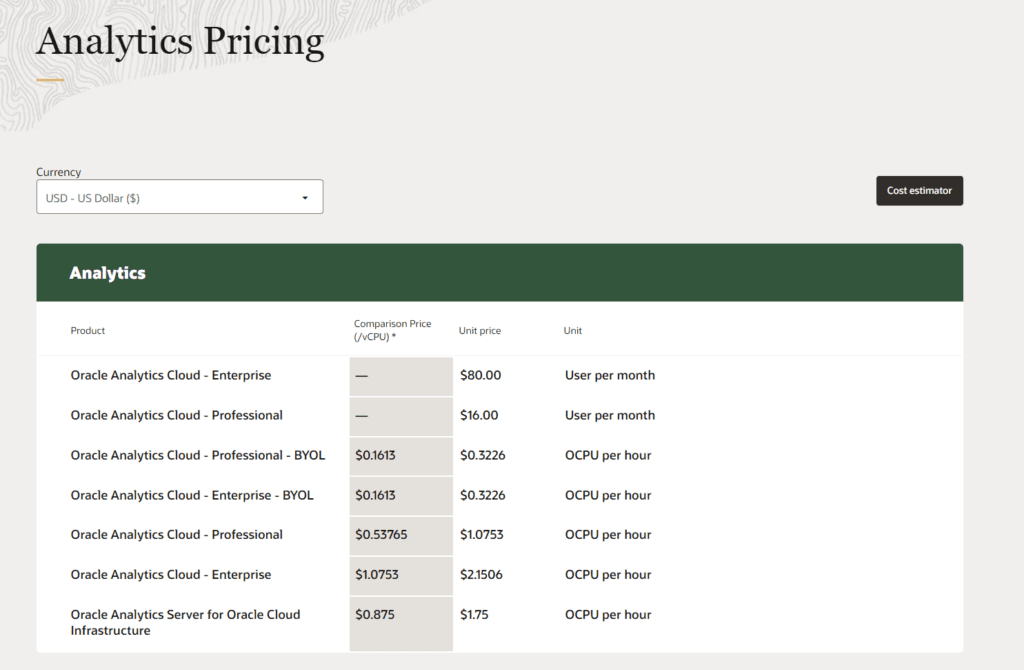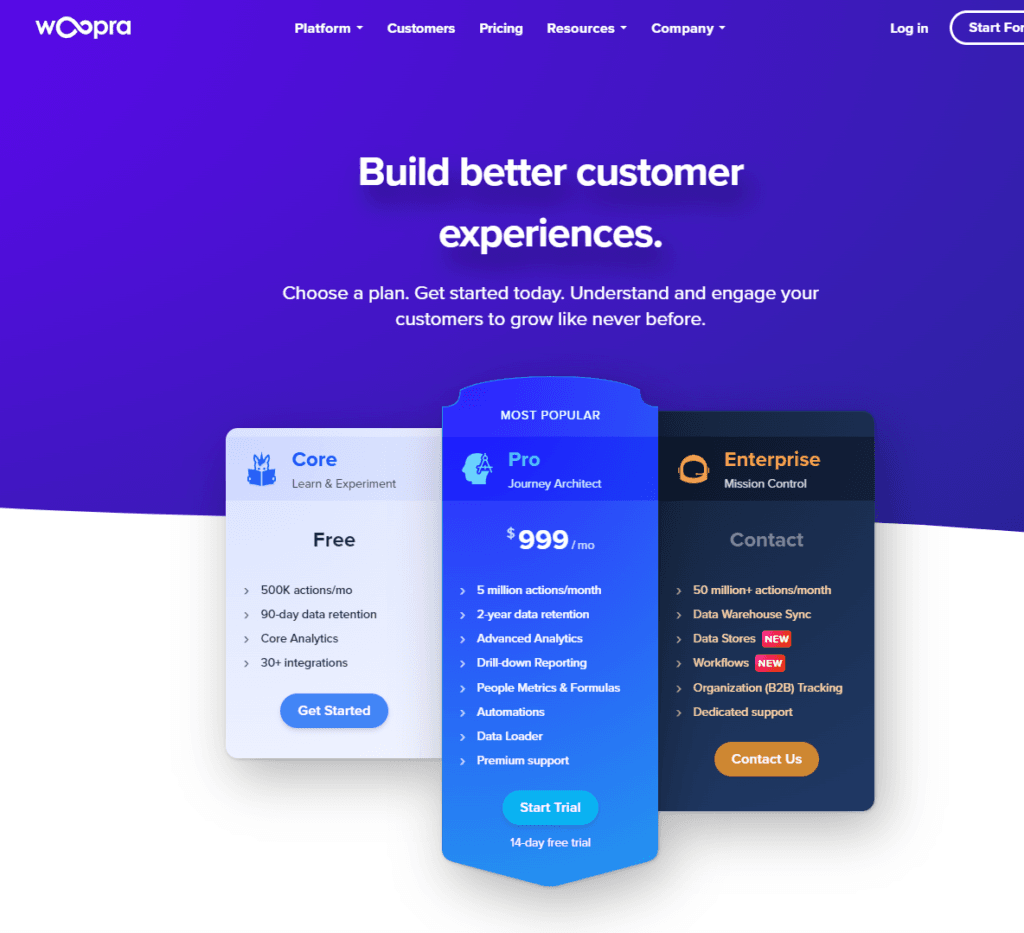Hey there! Are you on a quest to find the ultimate analytics tool that not only meets but exceeds your expectations? In the vast sea of data analytics, choosing the right platform can be as daunting as finding a treasure chest on the ocean floor. But worry not, because today we’re pitting two giants against each other: Oracle Analytics Cloud (OAC) and Woopra. Whether you’re a data wizard, a marketing guru, or just someone who loves to unravel the mysteries hidden in data, this comparison is tailored just for you. So, grab a cup of your favorite beverage, settle in, and let’s embark on this journey together to discover which tool might just be the key to unlocking your data’s full potential.
| Oracle Analytics Cloud | Woopra |
|---|---|
 |  |
| G2 Score -4.0 out of 5 | G2 Score -4.4 out of 5 |
| TrustRadius Score -8.1 out of 10 | TrustRadius Score -5.8 out of 10 |
Ease of Use and User Interface
In the world of data analytics, the ease of use and the intuitiveness of the user interface (UI) can significantly influence how quickly you can turn data into actionable insights. Let’s dive into how Oracle Analytics Cloud and Woopra fare in making data analytics accessible and engaging.
Oracle Analytics Cloud: The Powerhouse with a Learning Curve
Oracle Analytics Cloud is akin to a vast library filled with every book you could ever need. It’s powerful, comprehensive, and designed to cater to a wide range of data analytics needs, from the basic to the highly complex. The platform offers a wealth of features, including advanced analytics, AI-driven insights, and machine learning capabilities, all within a unified environment.
However, with great power comes a learning curve. New users might find OAC’s robust capabilities a bit overwhelming at first glance. The platform is built to cater to data scientists and analysts who are no strangers to data analytics, which means there’s a bit of a journey for newcomers to become proficient in navigating its depths. Oracle has made efforts to streamline the experience, offering guided tours, extensive documentation, and a community forum to help users climb the learning curve.
Woopra: Intuitive Analytics for Customer-Centric Teams
Enter Woopra, the nimble speedboat that zips across the data lake with ease. It’s designed with a laser focus on customer analytics, providing a seamless and intuitive experience for tracking customer journeys, behaviors, and trends. Woopra’s UI is clean and user-friendly, emphasizing simplicity and clarity to ensure that insights about your customers are always just a few clicks away.
Woopra excels in making analytics approachable for marketing teams, customer success specialists, and product managers. The platform enables users to quickly set up tracking without deep technical expertise, making it easier to derive insights and take action. With real-time data and a customizable dashboard, Woopra is tailored for teams that prioritize agility and immediate insights into customer engagement.
Customization and Flexibility
Both OAC and Woopra offer distinct approaches to customization and flexibility, catering to the diverse needs of their users. Let’s delve into how each platform enables businesses to tailor their analytics experience.
Oracle Analytics Cloud: Comprehensive Customization for Diverse Needs
OAC stands out for its vast array of customization options, designed to meet the intricate needs of large enterprises and data-heavy organizations. It offers extensive flexibility in data modeling, analytics, and visualization, allowing businesses to tailor the platform to their specific requirements.
OAC provides advanced data modeling tools that enable users to define custom data schemas, metrics, and KPIs, ensuring that analytics can be as granular as needed. The platform also supports the creation of bespoke analytics models, incorporating AI and machine learning for predictive insights. With OAC, the customization extends to the creation of interactive dashboards and reports. Users have the freedom to design complex visualizations that precisely match their reporting needs, incorporating a wide range of chart types, filters, and drill-down capabilities.
Woopra: Tailored Analytics with a Focus on Customer Insights
Woopra, with its emphasis on customer analytics, offers a different kind of customization, focusing on providing insights into customer behavior and journeys. It offers flexibility in how data is tracked, analyzed, and reported, making it particularly useful for marketing teams and customer success managers.
Woopra allows users to define custom customer journey stages and segment users based on their behavior, preferences, and demographics. This level of customization is invaluable for businesses looking to understand and optimize the customer experience. The platform provides tools for creating dynamic reports and dashboards that update in real-time, offering immediate insights into customer interactions. Users can customize these reports to focus on the metrics that matter most to their business, enhancing the ability to make data-driven decisions swiftly.
Pricing Overview
Both OAC and Woopra employ different pricing strategies, reflecting their target markets and the breadth of features they offer. Understanding these pricing models is key to evaluating which tool aligns with your financial constraints and analytics needs.
Oracle Analytics Cloud: Enterprise-Scale Pricing

Oracle Analytics Cloud is designed with large enterprises in mind, offering a powerful suite of analytics tools that can handle complex data environments. Its pricing model is structured to accommodate the extensive capabilities and scalability of the platform. OAC utilizes a subscription-based pricing model, where the cost is typically determined by the amount of data processed, the number of users, and the level of access to advanced features such as AI and machine learning analytics.
Given the customizable nature of OAC to fit specific enterprise needs, Oracle often requires businesses to engage directly for a tailored pricing quote. This approach ensures that organizations pay for exactly what they need but can make initial cost estimation more challenging. The investment in OAC is justified by its extensive range of features and the value it brings to large organizations looking to leverage analytics across multiple departments or functions. Businesses should consider the total cost of ownership, including potential costs for additional services and support.
Woopra: Flexible Pricing for Customer Analytics

Woopra offers a more straightforward pricing model, aimed at providing businesses with clear, scalable options for customer analytics. Woopra includes a free tier for small businesses or startups just beginning to explore customer analytics, with limitations on data points and features. Paid plans offer increased data capacities and access to more advanced features, with pricing based on usage.
One of Woopra’s strengths is the transparency of its pricing, readily available on its website. This clarity allows businesses of all sizes to easily understand the costs associated with each plan and select the one that best fits their needs. Woopra’s pricing model is designed to scale with the growth of your business, making it an attractive option for companies that expect their customer data analytics needs to evolve over time.
Security and Compliance
The security features and compliance certifications of OAC and Woopra are foundational elements that protect sensitive data and ensure organizations meet regulatory obligations. Let’s assess how each platform handles these critical concerns.
Oracle Analytics Cloud: Robust Security and Global Compliance
Oracle Analytics Cloud benefits from Oracle’s extensive experience in data security, offering a comprehensive suite of security features designed to protect data at every layer of the analytics process. OAC incorporates advanced security technologies, including encryption at rest and in transit, strong authentication mechanisms, and fine-grained access controls. These measures safeguard data against unauthorized access and potential security threats.
OAC adheres to a wide range of global and industry-specific compliance standards, such as GDPR for data protection in the EU, HIPAA for healthcare information in the US, and SOC 1 and SOC 2 for service organization controls. Oracle’s commitment to compliance ensures that organizations using OAC can confidently meet their regulatory obligations.
Woopra: Focused Security for Customer Data Analytics
Woopra, specializing in customer data analytics, implements targeted security measures to protect the data it handles, focusing on the privacy and security of customer information. Woopra emphasizes data privacy, offering features that comply with privacy regulations like GDPR and CCPA.
It provides tools for data anonymization and consent management, enabling businesses to respect user privacy while gaining valuable insights. While Woopra may not boast the extensive security certifications of a platform like OAC, it still employs rigorous security practices, including data encryption and secure data storage, to protect against data breaches and ensure the integrity of customer data.

Related: Check out our free SEO suite

Data Integration and Management
After setting sail with user interface comparisons, let’s navigate through the often complex waters of data integration and management. This journey will reveal how Oracle Analytics Cloud (OAC) and Woopra manage the crucial task of turning diverse data streams into a cohesive and actionable analysis.
Oracle Analytics Cloud: Mastering Complex Data Landscapes
OAC is like a seasoned captain when it comes to managing and integrating data. It’s built to handle the complexities of vast data landscapes, making it an excellent choice for organizations that operate across multiple domains and data environments. OAC supports seamless integration with a multitude of data sources, including other Oracle products, third-party SaaS applications, on-premises databases, and even flat files.
This platform doesn’t just stop at gathering data; it ensures that the data is primed for analysis. Through its robust data management capabilities, users can cleanse, transform, and enrich their data directly within the platform. This holistic approach to data integration and management streamlines the process from collection to insight, making OAC a powerhouse for organizations with complex data integration needs.
Woopra: Streamlining Customer Data for Actionable Insights
Woopra, with its sleek and nimble approach, focuses on providing a seamless experience for integrating and managing customer data. It’s particularly adept at tracking customer interactions across various touchpoints, offering businesses a comprehensive view of the customer journey. Integration with Woopra is straightforward, designed to connect effortlessly with popular marketing, sales, and product tools.
The strength of Woopra lies in its ability to provide real-time insights into customer behavior, enabling businesses to act swiftly on the data they collect. Its focus on customer data makes it a valuable tool for marketing teams, product managers, and customer success specialists who need to understand and react to customer needs promptly.
Conclusion
In wrapping up our exploration of Oracle Analytics Cloud (OAC) and Woopra, we’ve traversed through key terrains that shape the decision-making landscape when choosing an analytics tool. From ease of use, data integration, customization, security, compliance, to the pivotal aspect of pricing, each platform has revealed its strengths and areas of specialization.
READ NEXT:
- MicroStrategy vs Amplitude: The Best Analytics Tool for You
- MicroStrategy vs Zoho Analytics: The Best Analytics Tool for You
- Oracle Analytics Cloud vs Tableau: The Best Analytics Tool for You
- Microsoft Power BI vs Optimizely: The Best Analytics Tool for You
- 11 Marketing Analytics Tools to Elevate Your Data-Driven Strategies
- 29+ Digital Analytics Software to Skyrocket Your Digital ROI
- SugarCRM vs Bitrix24: The Best CRM Tool for You






















Comments are closed.